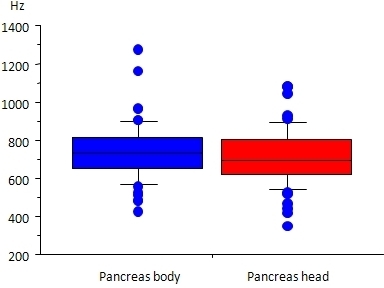Introduction: Consistency of the pancreas is one of the most important prognostic factors for pancreatic anastomosis. However, pancreatic stiffness had been evaluated, subjectively. We introduce a tactile sensor for digitize the consistency of the pancreas. Materials and methods: A material has its own resonance frequency. If material touches an oscillated object, a shift of the resonance frequency will be observed. The difference between the frequencies under pre and post oscillate conditions depends on the stiffness of the object. So, the consistency of material can be measured by monitoring the shift in the frequency. The tactile sensor system is composed of a sensor probe, an amplifier and a filter; the probe is connected to a piezoelectric transducer with a resonance frequency of 57 kHz. Measurements were made 200 times per second, and the magnitude of frequency change was processed by connected computer with original software. 61 patients with mean age 70.1 +- 9.5 were registered with this study. These patients did not have any clinical sign of pancreatitis. 34 patients had distal gastrectomy, 11 had total gastrectomy +- splenectomy and distal pancreatectomy, 5 had pancreatoduodenectomy, 3 had laparotomy alone and 8 patients had other procedures. Consistency of the pancreas was measured with a tactile sensor system (Venous Handy Biosensor system TM, AXIOM, Fukushima, Japan). Pancreas head and body (neck) were measured 2 or 3 times on the same point. If the patients had pancreatic tumor, the measurement was performed far from the tumor. Results: The consistency of the pancreas head was 721.7 +- 191.1 Hz. The consistency of the pancreas body was 741.2 +- 147.0 Hz. Conclusion: This method is easily maintained the consistency of pancreas non-invasively. Further investigation will be needed for elucidate the relationship between consistency and pancreatic leakage.
 500 Cummings Center
500 Cummings Center +1 978-927-8330
+1 978-927-8330
 +1 978-524-0461
+1 978-524-0461